The Golden Age Of Rolex Movements Part IV: Patents And Predictions For The Future of Rolex Watchmaking
by Tim Mosso
Rolex, for better or worse, has been described as a blue-chip brand built on blue-collar movements. There was a time when that old saw rang true; that time has long since lapsed.
Recent developments at the patent office suggest that the future of Rolex watchmaking may yield dramatic breaks with its conservative past. Atomic oscillators, advanced mechanical escapements, and unprecedented complications have the potential to remodel Rolex engineering in the image of avant-garde independent and boutique brands.
Rolex’s constant-force escapement: the one that got away
A past-as-prologue summary of Rolex research and development is a fitting introduction to the brand-defining innovations that might be in store.
This four-part survey of Rolex watchmaking opened with an account of the firm’s stodgy reputation entering the late 1990s. But beneath the surface, that period was an early wellspring of Genevois engineering vigor.
Alongside the concurrent development of the Daytona’s in-house caliber and innovations in hairspring metallurgy lay the groundwork of something far more ambitious.
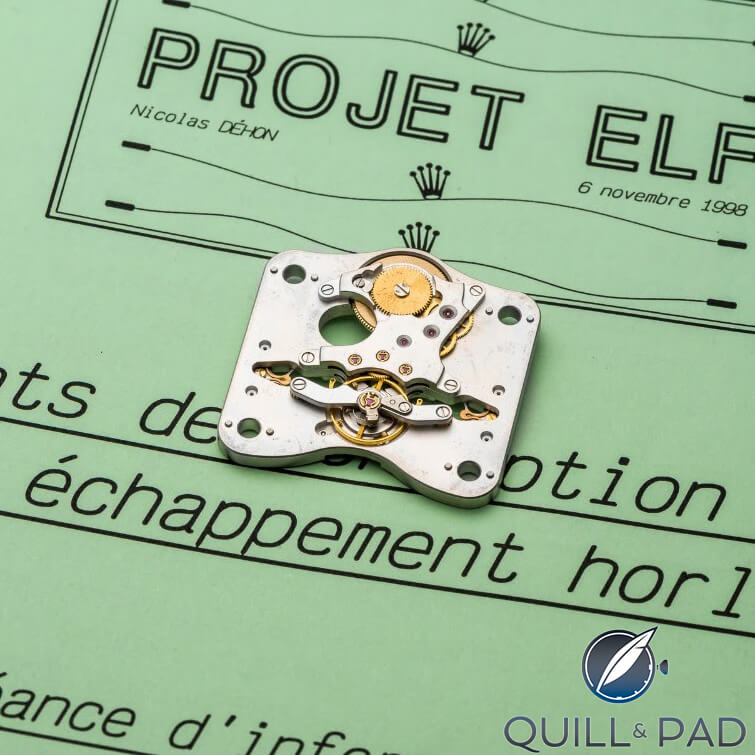
Rolex E.L.F. Caliber 7230 (photo courtesy Antiquorum)
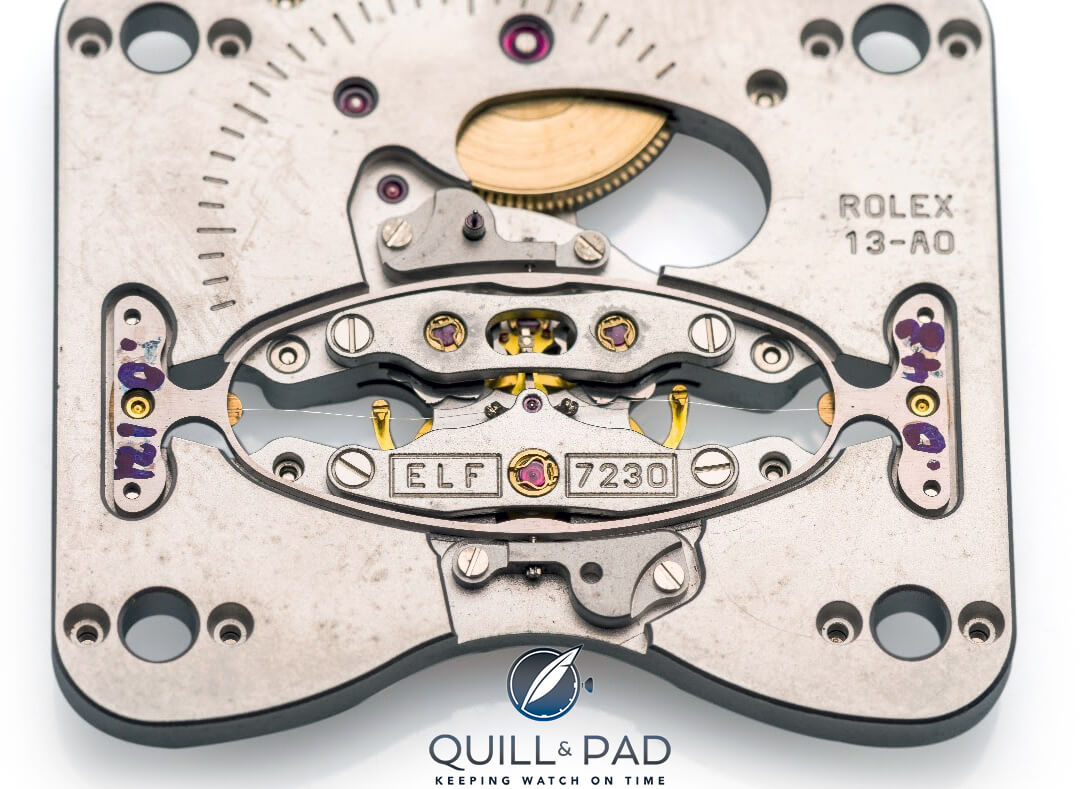
Rolex E.L.F. Caliber 7230 (photo courtesy Antiquorum)
The name Nicolas Déhon warrants a mention precisely because his name appears on no granted U.S. or international Rolex patent for the most interesting watch movement that Rolex never brought to market.
In 1998, Déhon devised a primitive constant-force concept movement with Rolex caliber number 7230. An eternity later, the serialized and silicon-infused progeny of this primordial prototype would win the 2013 Grand Prix d’Horlogerie de Genève’s Aiguille d’Or as the Girard-Perregaux Constant Escapement L.M.
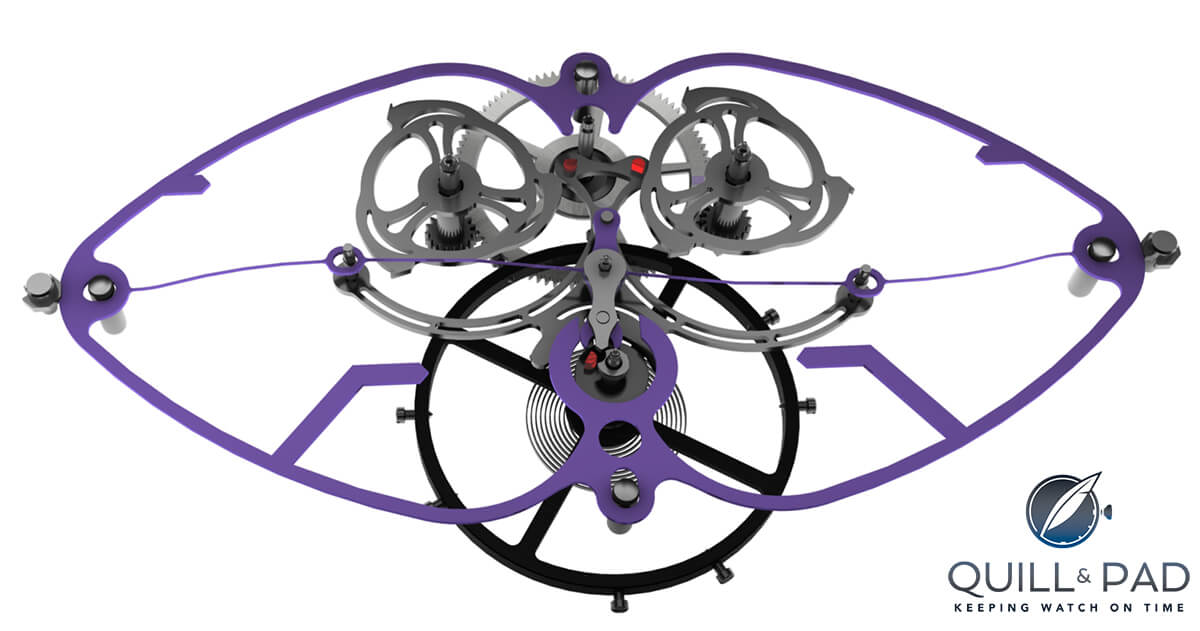
The Girard-Perragaux Constant Escapement
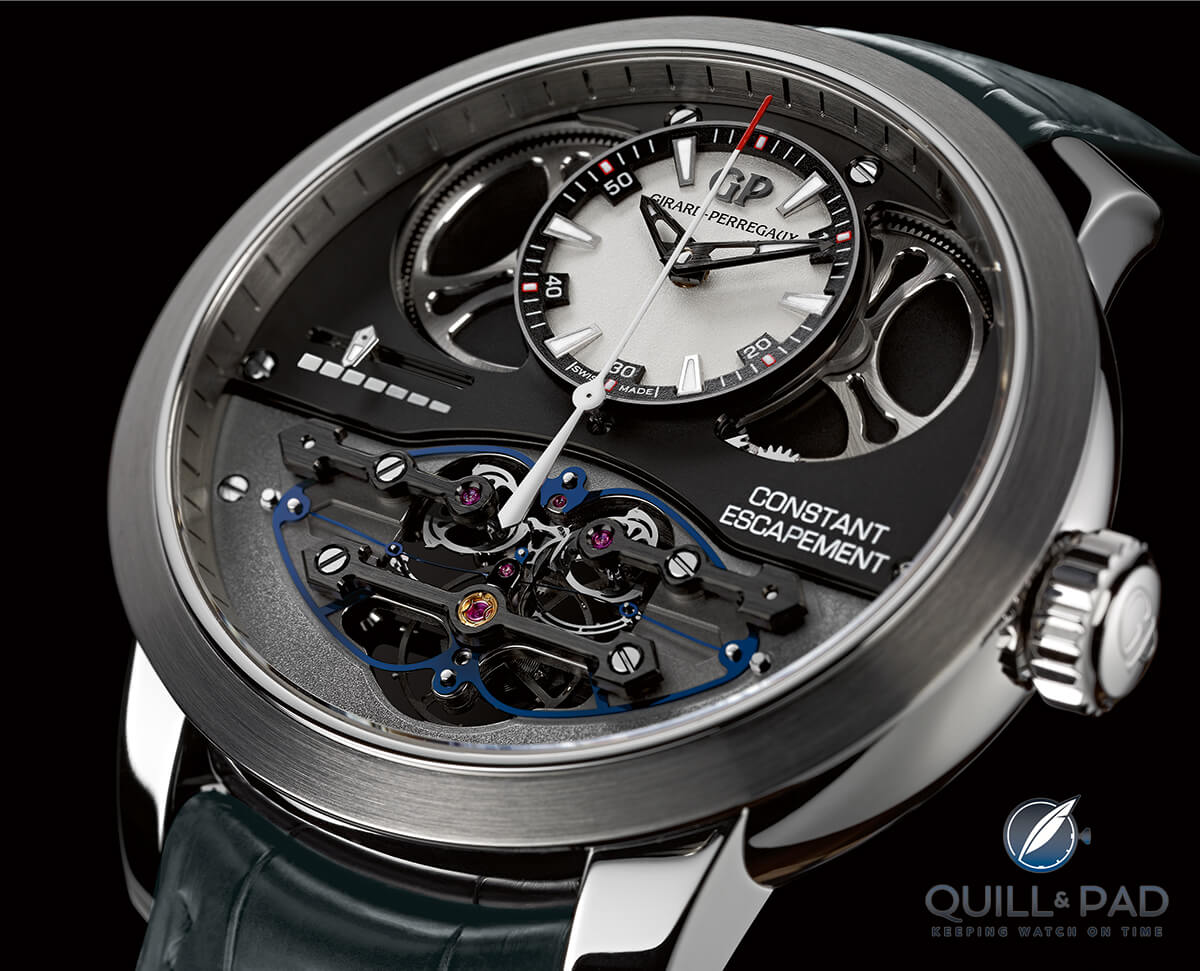
Girard-Perragaux Constant Escapement
But wait, there’s more (with Rolex there usually is)
The entire Project E.L.F. episode often is mentioned as a tantalizing and frustrating what-might-have-been tale peddled in Rolex collector forums and watch magazine copy. It isn’t quite watchmaking’s version of the mythical Ted Williams-for-Joe DiMaggio trade proposal of 1947, but it’s darn close.
Don’t look now, but we’re about to play nine innings of fantasy baseball with Rolex’s recent U.S. patent filings, and exotic escapements are back in the game. Rolex started playing hardball at the patent office in December 2009 with the filing of U.S. patent number 7927008, “a detent escapement for a timepiece comprising a balance wheel fastened to an impulse element, an escape wheel the teeth whereof intersect the trajectory of the impulse element, a detent swing-arm having a stop element and a disengagement element.”
U.S. patent number 8087819, filed three months after the December 2009 application, offered additional clarity on the consumer-wristwatch tailoring of the ancient detent chronometer system: “the present invention relates to a direct-impulse escapement, especially of detent type, for a horological movement . . . the main advantage of such an escapement is that it is has higher resistance to shocks.”
In the footsteps of Robert Robin . . . and Audemars Piguet
If these Rolex filings sound broadly similar to the concurrent direct-impulse Audemars Piguet Escapement, that’s no coincidence: both Rolex’s 2009 patent application and AP’s press copy cite eighteenth-century French watchmaker Robert Robin’s direct-strike escapement as the conceptual root of their engineering.
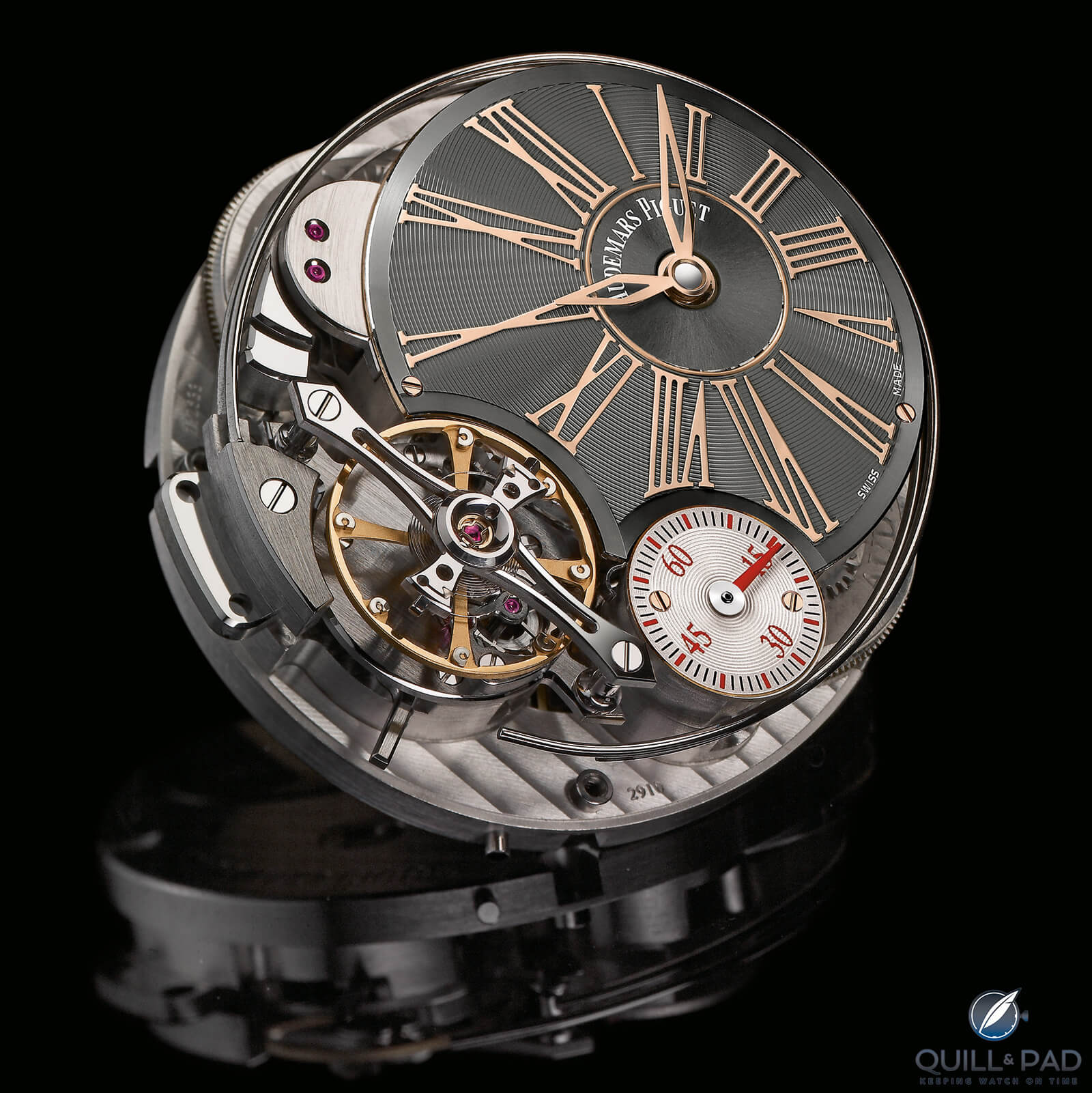
Audemars Piguet Escapement
The drumbeat of esoteric escapement patents has endured and escalated. While the 1990s Déhon escapement represented the onset of these studies, and detent regulators marked the revival of such systems, Rolex drove deeply into a wristwatch revision of the Robin escapement in July of 2011 with the application for U.S. patent number 8480293 stating the following: “a timepiece furnished with a direct impulse escapement, comprising a frame on which are pivotingly mounted an escapement wheel, a locking lever for locking the escapement wheel furnished with two locking pallets, with a fork and with a guard pin . . . a disengagement pin and a detent for allowing the guard pin to pass.”
Whereas the first two Rolex detent escapement patents discussed history, shortcomings of previous detent systems, and conceptual solutions to their shortcomings, the July 2011 application was far more advanced in its discussion of specific mechanisms and the underlying engineering mathematics.
This was beginning to look like a project on its way to prototyping – or beyond. In March of the same year, U.S. patent number 8882339 expressly detailed the fabrication by DRIE or LIGA of the critical guard pin mathematically defined in the July filing.
Additional accounts were offered in 8882339 regarding the “Method For Producing a Timepiece,” right down to the process of joining the guard pin to the movement plate.
So where’s my Rolex direct-impulse escapement?
Given the foregoing, why aren’t we wearing direct-impulse Pepsi GMT-Masters today? Several speculative explanations apply.
First, the 2015 Rolex Chronoergy escapement likely was viewed as a more conventional alternative to a truly exotic escapement.
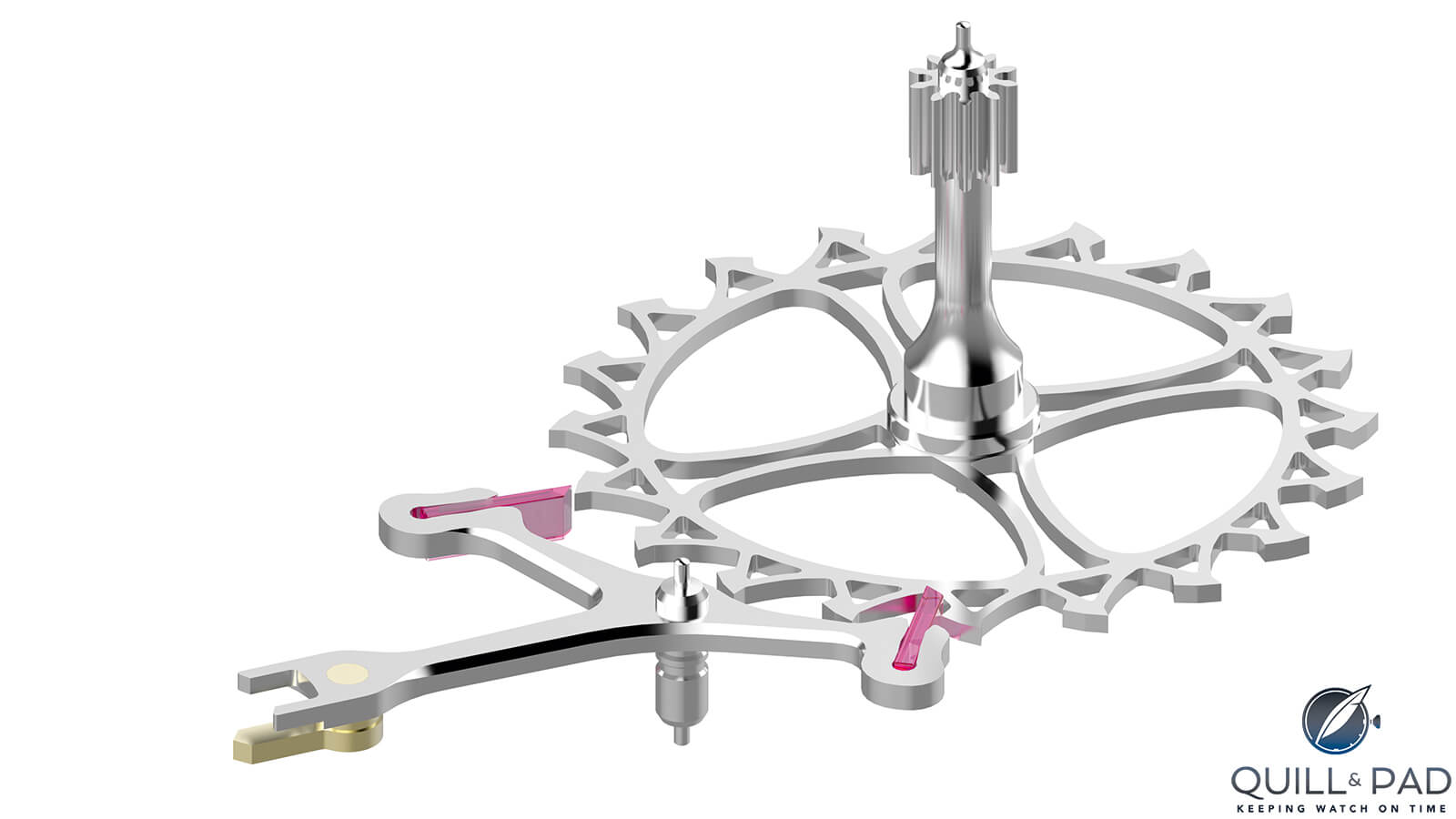
Rolex Chronergy escapement
Patents for the Chronergy lever and wheel appear in the U.S. patent record; additional patents protect the thin-wall mainspring barrel that permitted a larger mainspring. Therein lie the keys to Rolex’s current 70-hour power reserve standard, the expanded five-year warranties, and the Superlative Chronometer two-second-per-day accuracy attestation. With bullet points like that, it’s not clear that risky technology carries any end-user advantages.
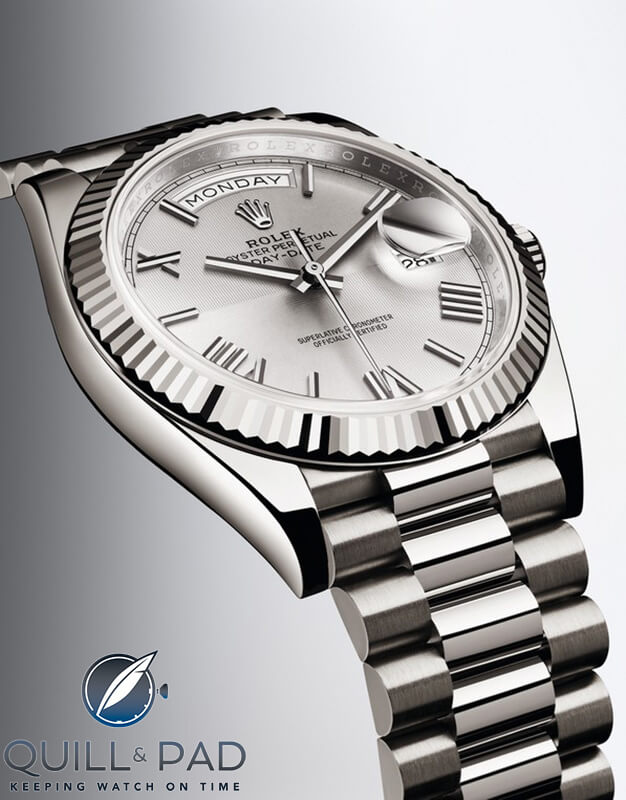
Rolex Day-Date 40 with Chronergy escapement
Second, it may be that Rolex believes single-direct-impulse escapements to be a dead end. Aside from the AP Escapement of the 2000s, most successful direct-impulse wristwatch systems have employed two wheels. “Double-direct” escapements have ticked inside movements by F.P. Journe, Laurent Ferrier, Kari Voutilainen, and Charles Frodsham to great success over the last eight years.
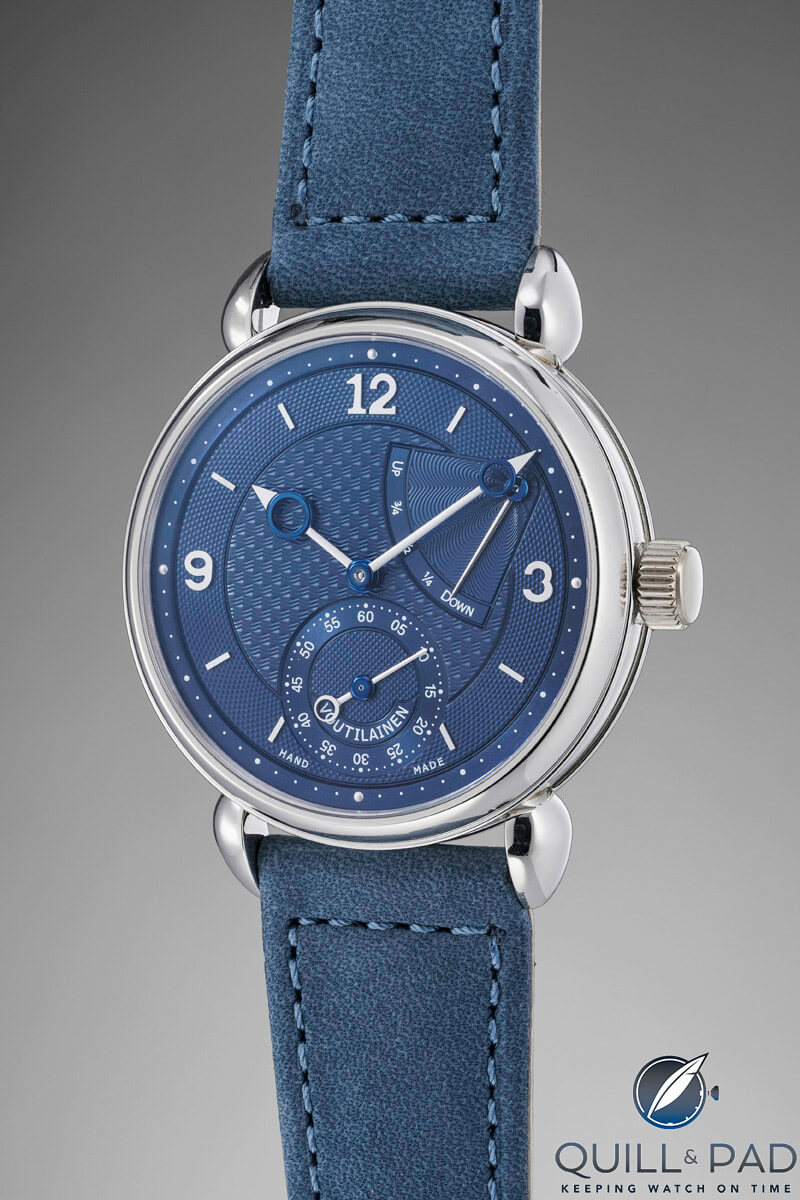
Kari Voutilainen Vingt-8 Power Reserve (photo courtesy Phillips auctions)
Third, and most tantalizing, is the prospect that Rolex research on exotic escapements continues; the last detent system patent was granted as recently as 2014, and prototypes may exist now; a quantum leap, by definition, needs to be made all at once or not at all.
Dawn of the atomic age
Two patent filings suggest that current Rolex exotic-regulator research and development may have abandoned detent escapements.
Rolex considers atomic oscillators to be viable at wristwatch scale. In March 2012, Rolex submitted a concept for a wristwatch-sized atomic clock that employs Ramen-effect photon detection to miniaturize an atomic clock and achieve sustainable battery life for the system.
U.S. patent number 8922283 describes precisely this arrangement built around a cesium or rubidium core. Most intriguing is the stated accuracy goal of less than one second of error per year.
While that precision is routine for atomic timekeepers, the size – a normal Rolex wristwatch – would be revolutionary if brought to market. Previous efforts to bring personal atomic clocks to the personal horology space have employed an atomic clock to set a watch (Urwerk’s $2.7 million AMC) or a watch-shaped radio receiver that receives a signal from an industrial atomic clock.
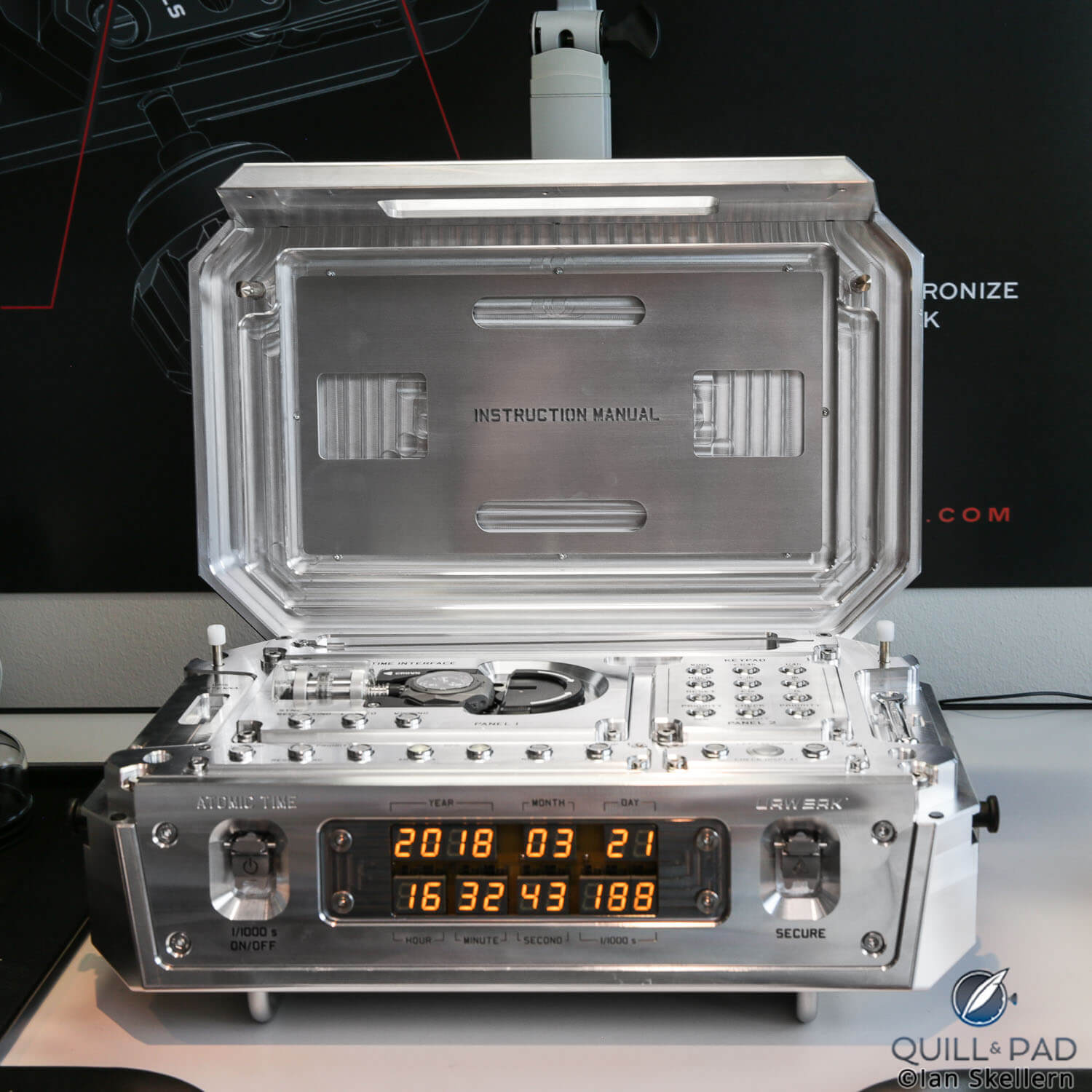
Urwerk AMC
Rolex name-drops Christian Klings. In. A. Patent.
While intriguing – and quasi-heretical – the reborn Rolex electric watch appears to have in-house competition from traditional mechanical watchmaking concepts. Incredibly, Rolex found its inspiration within the small circle of Académie Horlogère des Créateurs Indépendants (AHCI) independent watchmakers.
German AHCI member Christian Klings became a proponent of an obscure “free-balance” impulse system during the 2000s.

Christian Klings
The “free balance” is a force-transmission method by which alternating tension applied to the hairspring is used to maintain amplitude, and no direct-drive exists between the watch’s going train and its balance wheel.
In U.S. patent number 9081365, Rolex even gave a shoutout to Klings and his free-balance tourbillon, “In 2005, the watchmaker Christian Klings also proposed a tourbillon based on the same concept.” It’s not every day that a Rolex patent references both a one-man brand and a tourbillon regulator.
By eliminating the impulse of an escapement against the balance, the free-balance system surpasses the potential efficiency even of direct-impulse systems.
The summer 2015 grant of the Rolex free-balance patent suggests that in engineering terms, this engineering solution remains within the research-and-development phase; the more dramatic the break with existing technology, the longer the basic research phase. It’s unlikely that the next Rolex Submariner will bow at Baselworld with a zero-contact escapement, but all bets are off for the 2030 GMT . . .
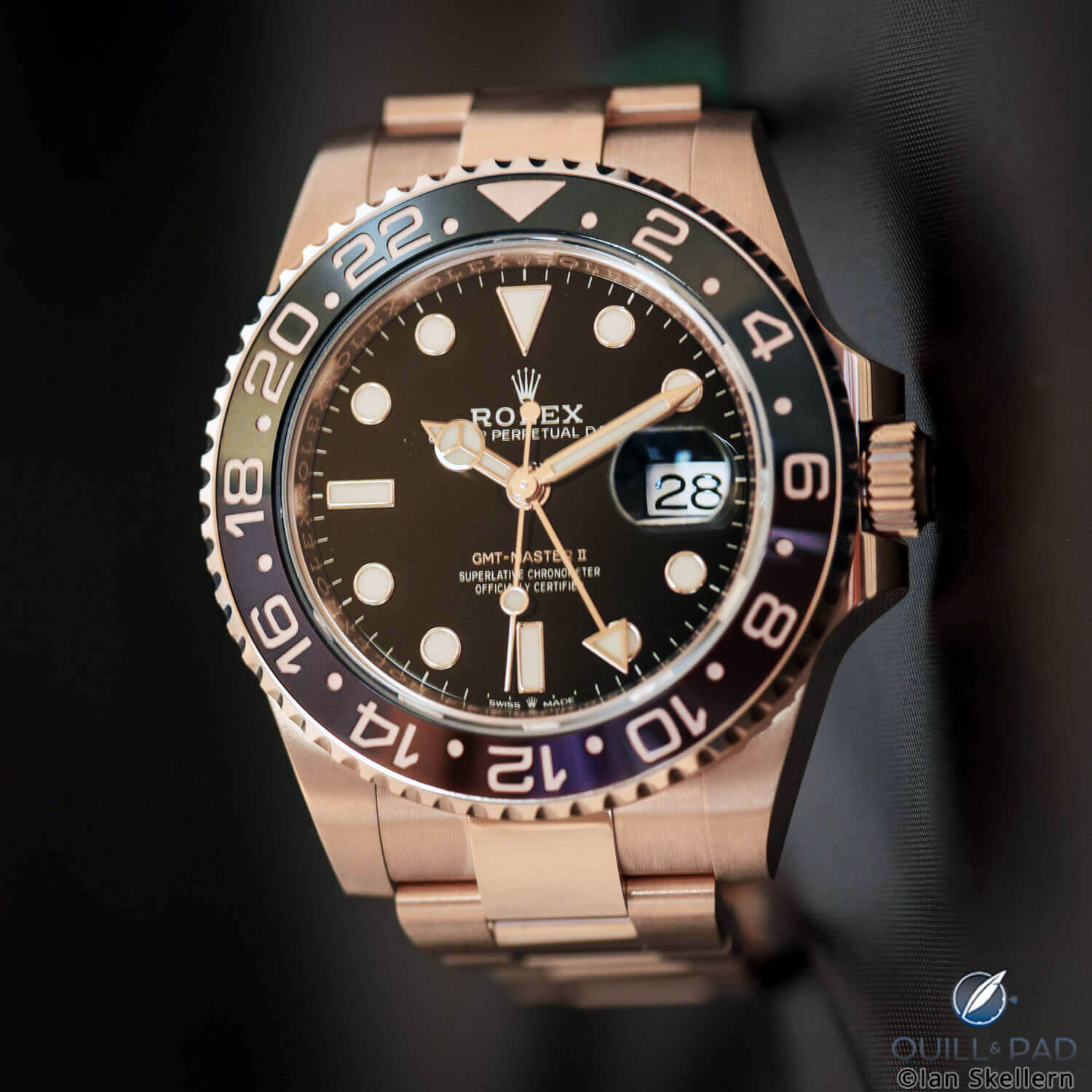
Anything is possible
Future Rolex plans: dead giveaways at the patent office
Recent Rolex patent filings suggest that relatively instant gratification may be close at hand for fans of complicated watches. If one quality is evident in Rolex’s patent patterns, it is the greater detail and design granularity that appears as a concept moves toward the product phase. There are times when these insights read as virtual product previews.
Consider the final patent application in advance of the 2012 Sky-Dweller GMT annual calendar launch. Whereas previous Rolex annual calendar patents had related to underlying mechanisms, U.S. patent number 8830797 gave away the physical appearance of a calendar watch on which, “the months mobile turns through an angle of 30° each month, wherein said indicator dial has twelve windows that are angularly equidistant.”
The twelve-month displays, therefore, amounted to a 360-degree array of windows corresponding to the twelve hours of the day; any police sketch artist worth her salt could have scrawled a basic Sky-Dweller dial upon reading that patent.

Rolex Sky-Dweller in steel and gold
Like the hands of a watch, Rolex product development moves in cycles. The 2011 Rolex Explorer II broke new ground with a 42 mm case; the next Explorer II might break new ground with an entirely different time display.
While this is purely speculative, the related patent is real. One year after the arrival of the current Explorer II, Rolex filed U.S. patent 9405274 for a “Timepiece Capable of Displaying Two Time Zones.”
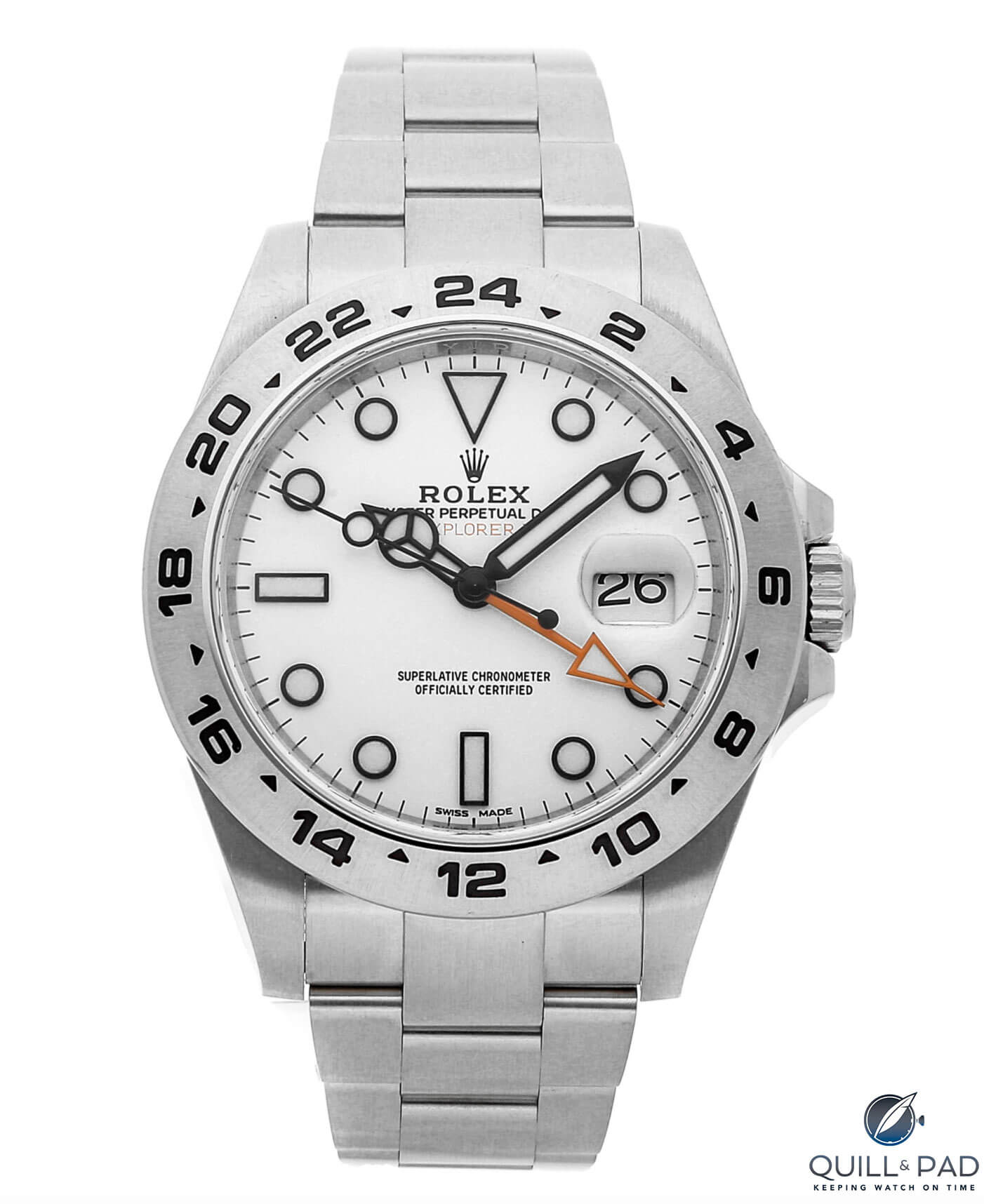
Rolex Explorer II Reference 216570 (photo courtesy WatchBox)
The dual-time system described in this patent reads as engineering elegance worthy of Andreas Strehler. Rolex watch engineers envisioned a system whereby a mechanical memory retains two independent time zones while employing only a single set of hands. It comprises, “a time-display member . . . and a switchover mechanism . . . allowing the time-display member to switch between a first time zone and a second time zone.”
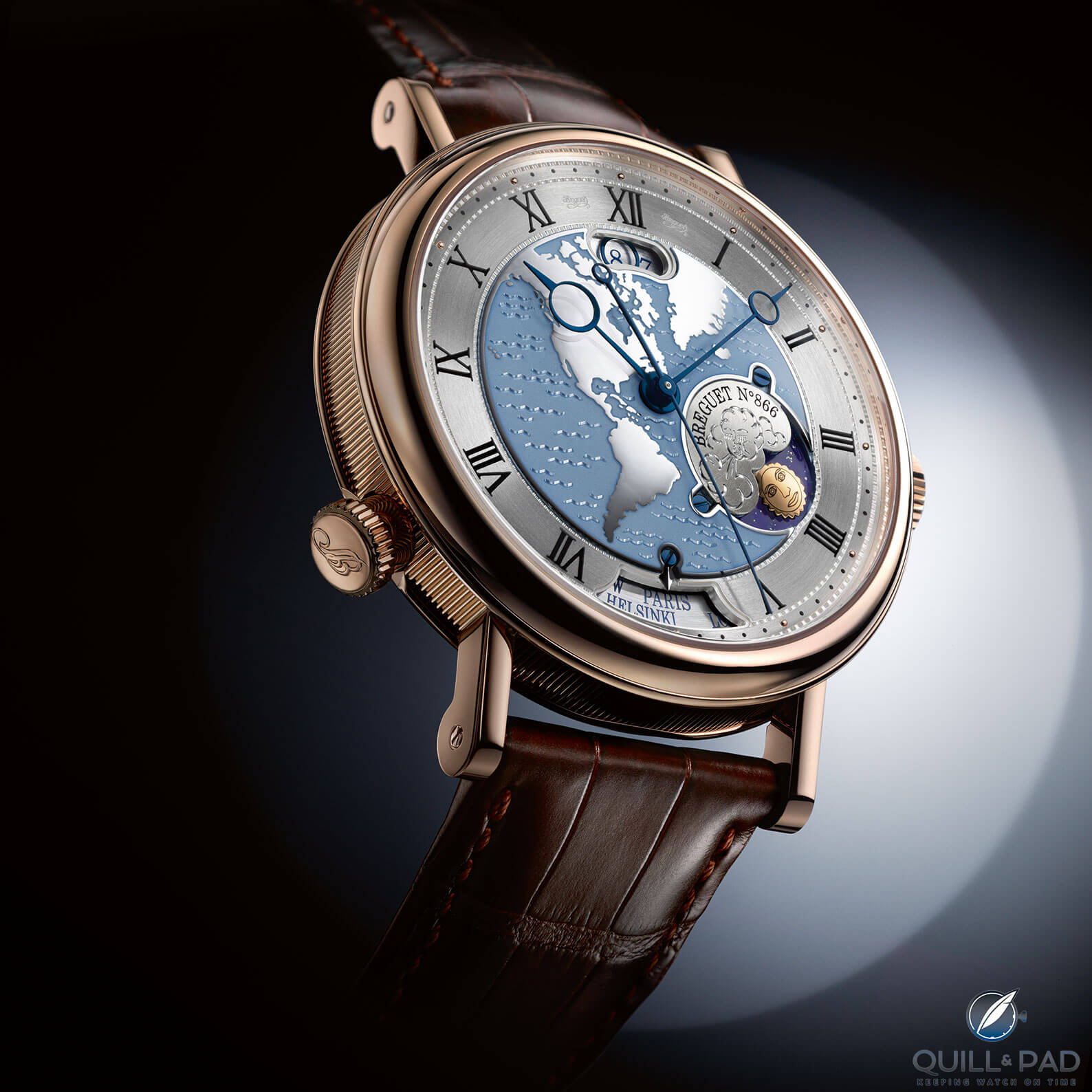
Breguet Hora Mundi Reference 5717
If this sounds like an abstraction of the 2011 Breguet Classique Hora Mundi Reference 5717, that is because Rolex envisions precisely that level of cloaked complexity in a future dual-time watch.
Moreover, Rolex matches the Breguet’s ability to set the minutes and hours independently of each time zone rather than the conventional dual-time watch’s propensity to allow only independent hour indications. And the Rolex patent goes one better than the Breguet by incorporating, “a display member . . . for displaying the time difference between the two time zones, notably in number of hours.”
Rolex Daytona with split-seconds
While the current Explorer II is approaching old age as a model, the current 19-year-old Rolex Cosmograph Daytona is a mechanical Methuselah. In fact, the functionality and design of the current Daytona has changed little since the 1988 arrival of the first automatic 40 mm Cosmograph powered by its Zenith El Primero caliber.
The first installment of this Rolex technology series opened with the year 2000 launch of the current Daytona, and this final installment will end with a nod toward the Daytona’s future.

Rolex Daytona Reference 116500LN
Rolex’s U.S. patent filed in May of 2014 describes the shortcoming of a conventional split-seconds chronograph as follows: “the main disadvantage with the conventional split-time chronograph is that it is unable to store times in excess of one minute.”
The language of the patent leads naturally to the discussion of remedies for a standard rattrapante chronograph’s faults: “to overcome this shortcoming, patent application EP1584997 discloses a split-time chronograph that allows the seconds and minutes of a timed period to be stored . . . extended to the number of minutes which are displayed by the minutes counter of the chronograph, thirty minutes in that instance.”
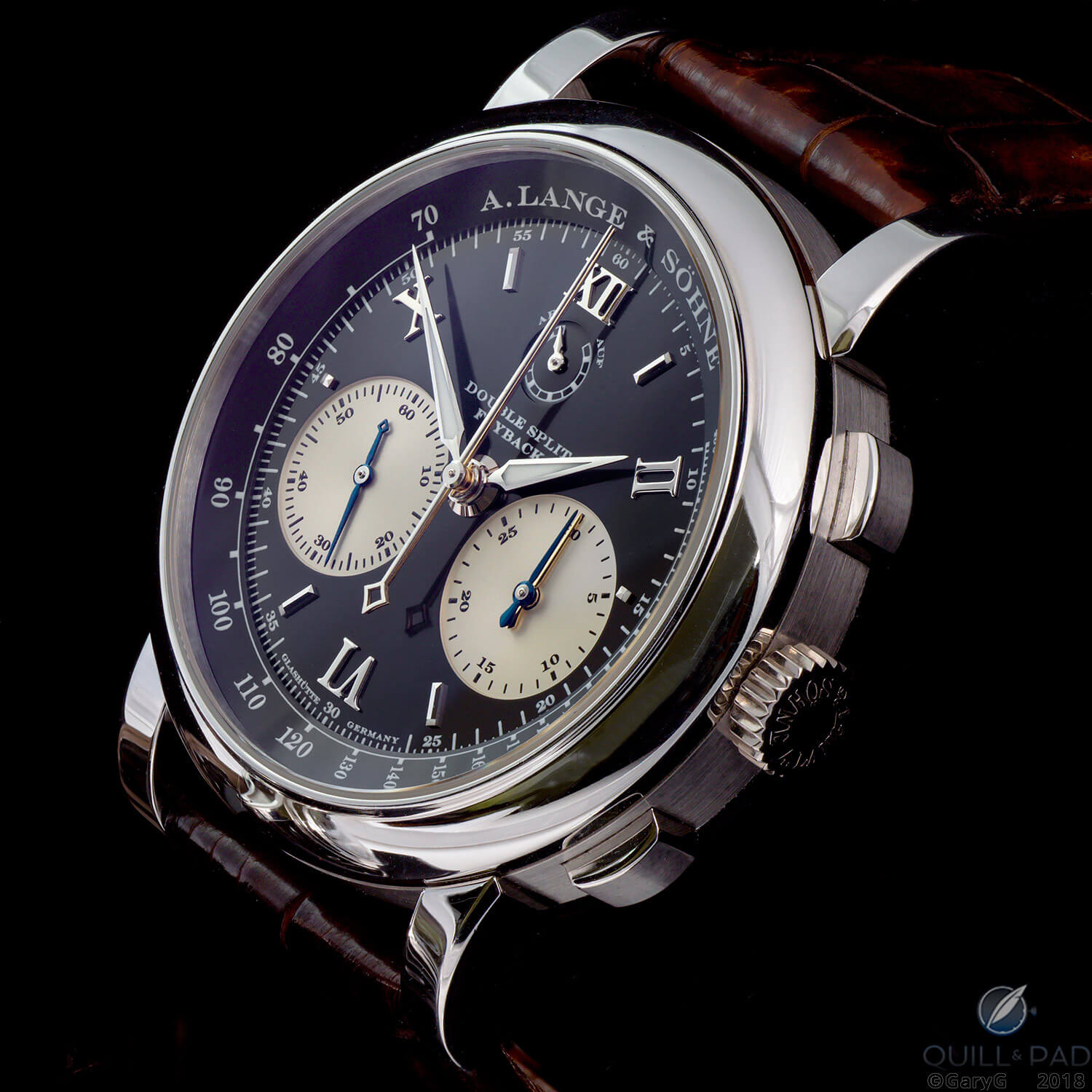
A. Lange & Söhne Double Split
The holder of European patent 1584997, filed in April of 2004, is listed as none other than “Lange Uhren GmbH.”
Of course, the watch described therein is the original A. Lange & Söhne Double Split – a decidedly ambitious target for Rolex’s product planners. At least as far as the patent office is concerned, Rolex appears to be looking far beyond its usual rivalries at Omega and Breitling.
Rolex’s patent ultimately proposes a chronograph capable of splitting and retaining separate measures of seconds, minutes, and hours.
Is the world ready for a Rolex Daytona Triple Split?
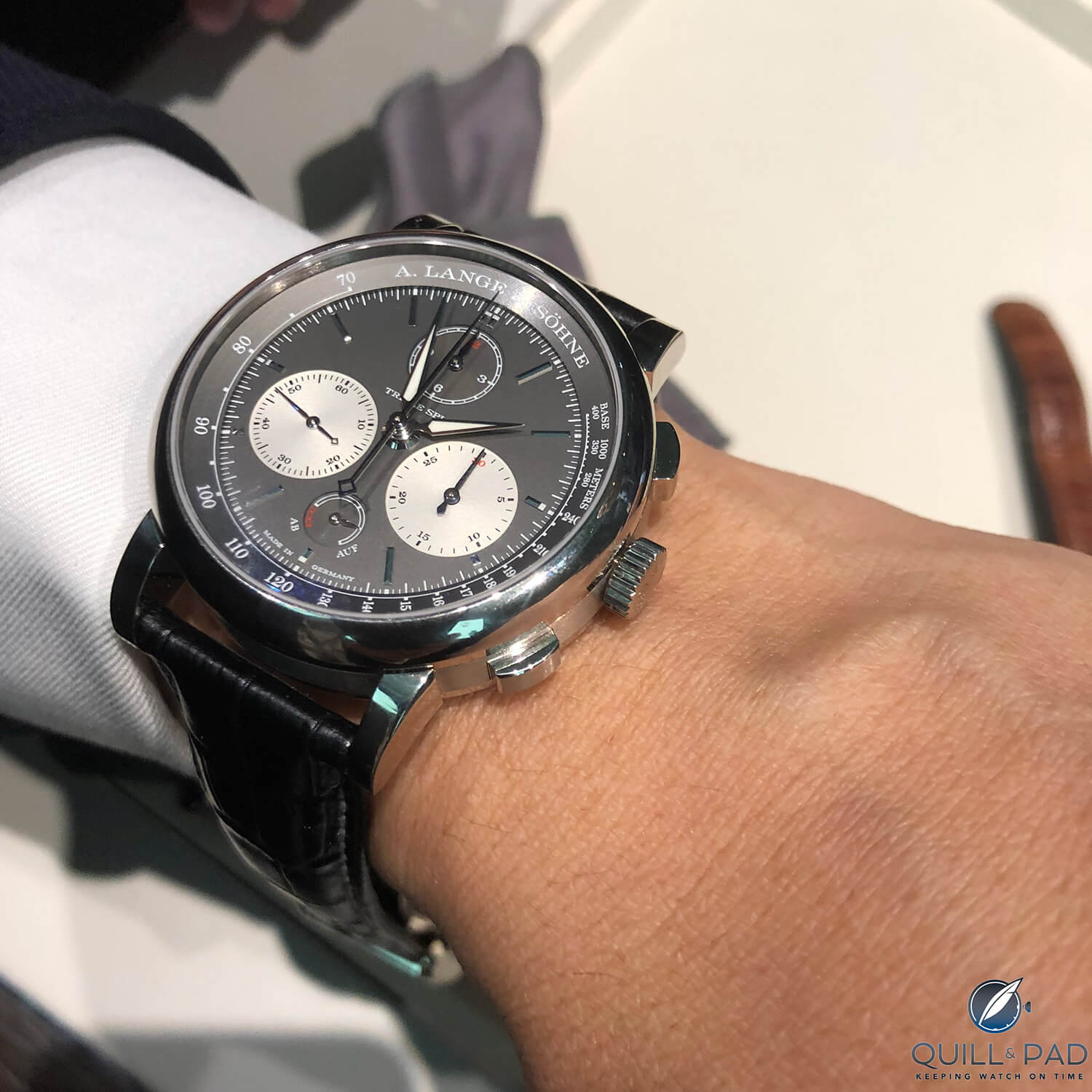
A. Lange & Söhne Triple Split (photo courtesy AllenS)
As if to anticipate a new generation of complicated Rolex watches, a large number of “pusher actuator” and “crown position” patents have been filed over the last decade to flesh out the accessory components required to control multi-mode movements.
Based on Rolex’s U.S. patent filings of the last decade, the road from Rolex Geneva to the halls of Baselworld is paved with tantalizing prospects and the promise of potentially shocking developments.
Quick Facts Girard-Perregaux Constant Escapement L.M.
Case: 46 x 14.4 mm, titanium
Movement: manual winding Caliber 09100-0002 with constant force escapement, 144-hour power reserve, 3 Hz/21,600 vph frequency
Functions: hours, minutes, seconds, power reserve indicator
Price: $91,400
Quick Facts Rolex Oyster Perpetual Day-Date 40 Reference 228239
Case: 40 x 12 mm, white gold
Movement: automatic Caliber 3255, 70-hour power reserve, 4 Hz/28,800 vph frequency, officially certified C.O.S.C. chronometer
Functions: hours, minutes, hacking seconds; day, date
Price: $37,550
Quick Facts Breguet Classique Hora Mundi Reference 5717
Case: 43 x 16.6 mm, platinum
Movement: automatic Caliber 77F0, 55-hour power reserve, 4 Hz/28,800 vph frequency
Functions: hours, minutes, hacking seconds; date, dual time with alternating display, city-of-reference indicator
Price: $94,200; other metals and dials exist at varying prices
Quick Facts Rolex Oyster Perpetual Explorer II Reference 216570
Case: 42 x 13.4 mm, stainless steel
Movement: automatic Caliber 3187, 48-hour power reserve, 4 Hz/28,800 vph frequency, officially certified C.O.S.C. chronometer
Functions: hours, minutes, hacking seconds; 12/24 hour dual time
Price: $8,100 (black and white dials)
Quick Facts Rolex Oyster Perpetual Cosmograph Daytona Reference 116500LN
Case: 40 x 12.2 mm, stainless steel
Movement: automatic Caliber 4130, 72-hour power reserve, 4 Hz/28,800 vph frequency, officially certified C.O.S.C. chronometer
Functions: hours, minutes, hacking seconds; chronograph
Price: $12,400
Quick Facts A. Lange & Söhne Double Split
Case: 43.2 x 15.3 mm, platinum
Movement: automatic Caliber L001.01, 38-hour power reserve, 3 Hz/21,600 vph frequency
Functions: hours, minutes, hacking seconds; power reserve indicator, split seconds and minutes chronograph
Price: $126,800 (2016); other metals and dials exist at varying prices
You may also enjoy:
The Golden Age Of Rolex Movements Part I: Sowing The Seeds Of Greatness
The Golden Age Of Rolex Movements Part III: Branding vs. Breakthroughs In Recent Years
Is Silicon Here To Stay In (Rolex) Watch Movements?
A Very Rolexy Rolex Discussion: 3 Reasons The Rolex Day-Date 40 Convinced Me
Leave a Reply
Want to join the discussion?Feel free to contribute!



Saved the best for last. Massively enjoyable read.
Thanks for following me on Quill & Pad! My next feature with be a photo study with brand context and product highlights centered on the De Bethune DB28 Steel Wheels, so be sure to look for that in the near future.
Best,
Tim
Great article. One minor mistake : It’s Raman Effect (named after Dr CV Raman) https://www.britannica.com/science/Raman-effect
Thank you for this kind feedback and course correction.
Best,
Tim
Wow what an incredible article, my watch-nerd itch has been scratched good !!
Quick thought: Im a big fan of the OysterQuartz, and Ive read they had a perpetual calendar movement ready to go that was shelved at the last minute. Given what we now know about their research into exotic movements, ditching quartz would actually be the forward thinking move. Maybe the OQ case design will make a return but with an atomic regulated movement, and since it needs batteries it would have a narrative through-line.
Thanks Tim, incredible article.
Amazing article. Wonderful read. Some of these upcoming innovations are mind boggling. Please keep them coming.
Sk